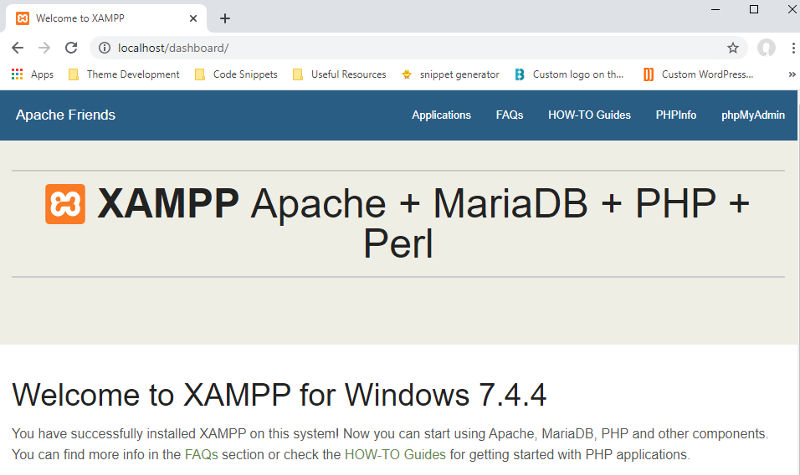
- #Wordpress install localhost xampp how to
- #Wordpress install localhost xampp software
- #Wordpress install localhost xampp download
- #Wordpress install localhost xampp free
#Wordpress install localhost xampp how to
So, let’s explore how to install WordPress on your computer. We think you are waiting to know how to install WordPress on your local server and start developing your website. You don’t need any live server to run such files. You can install WordPress or run PHP files using this server on your computer locally. Now, You have successfully installed XAMPP on your computer. Click on the “ Allow Access” button for both Apache and MySQL so as to run the applications.Īfter clicking the button, the status for them will turn green. Then, in some installations, you may see a Windows firewall notification as shown in the image below. You will see the start button next to Apache and MySQL. If the installation process went well and everything is running smoothly, the control panel will then automatically be opened after that. Leave this option ticked and click Finish After finishing the installation: Once installed, you’ll be asked whether you would like to start the XAMPP Control Panel, which provides an interface for running your localhost environment.
#Wordpress install localhost xampp free
Since we’re going to install WordPress manually later in this tutorial and don’t need free installers, untick “Learn more about Bitnami for XAMPP” and click Next.Īfter going through all those initial installation steps, XAMPP is now finally ready to install. In the next window, you’ll be asked whether you would like to install Bitnami for XAMPP, which offers free tools for installing WordPress, Drupal, and Joomla! on top of XAMPP. I’m going to create a new folder in D:\Program Files\XAMPP. We recommend you to use the partition other than your operating system drive partition because even if you decide to change the operating system later you won’t lose any of your current work. Next, select the folder where you would like to install XAMPP on your machine. Therefore let them be checked and uncheck the remaining options. Since we want to run WordPress in our localhost environment, we need MySQL and phpMyAdmin. It’s up to you which components you want to install.
#Wordpress install localhost xampp software
Some options, such as Apache and PHP are essential to running the software and will at automatically installed, so they are grayed out so you can’t select them. In the next window, you will be asked to select which components of the software you would like to install and which ones you don’t want. The XAMPP setup wizard will guide you through the installation. As you would when installing any software on Windows, use your best judgment, but you probably want to click “Ok” to continue with the install.
#Wordpress install localhost xampp download
Go to the Apache Friends website and download XAMPP.ĭuring the install process, you may receive warnings such as Windows asking you if you’re sure you want to install the software and the installer prompting you about antivirus software. XAMPP provides the necessary environment needed to run WordPress on a local machine. WordPress isn’t a stand-alone application and requires server software in order to run. Since XAMPP is cross-platform, it also works on Mac and Linux, but today we’re going to focus on how to set up XAMPP on Windows 10. It’s a simple and lightweight solution that allows you to create a local web server for testing purposes. XAMPP stands for cross-platform, Apache, MySQL, PHP, and Perl. Below is the step-by-step tutorial prepared for beginners.

Today we will learn how to install WordPress locally on XAMPP on our computer as localhost. Though it is sometimes a hectic task to install a local host, believe us, once it is done it’s a breeze to run and will save you a bunch of time if you need to run WordPress locally. Having a local host environment is an essential part of WordPress workflow. You can install WordPress locally on XAMPP on your own Windows computer for learning and testing.

Localhost is a hostname that means this computer.


 0 kommentar(er)
0 kommentar(er)
